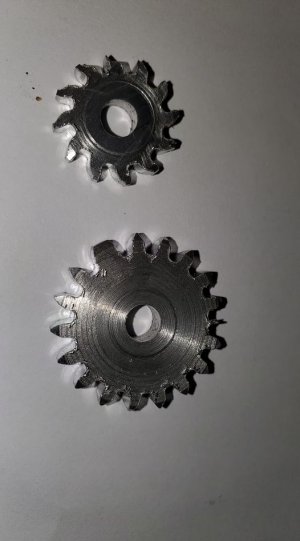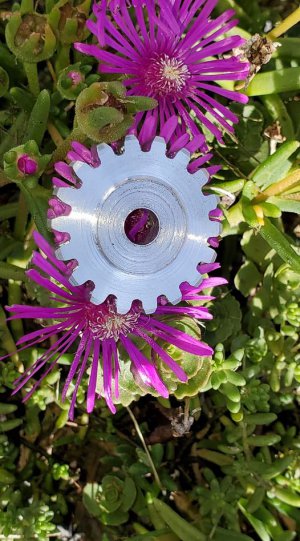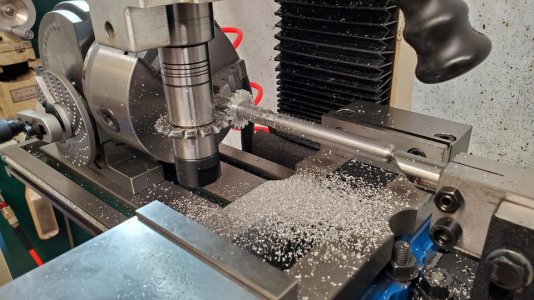- Joined
- Mar 2, 2018
- Messages
- 232
I was about to cut my very first gear. I knew I would need lots of practice to master the whole crank 12 times and 17 holes thing, so i wanted to make it easy on myself, and just use the front plate. You know, the one that has the handy dandy little stick out plungie thing that locks dead on a hole, and no need to think about no steeking backlash or math.
In fact, as a lead up to this, I cut my first hexes with this setup. 36 / 6 = 6. 0, 6, 12, 18, 24, 30, back to 0. BOOM! I am a machinery chammmmpion!!!
I cut a few hexes with this setup, and I was pretty confident I had figured it all out. Then I went to cut my 18 tooth gear. 18, because it was a blank I could turn out of aluminum I had on hand.
So yeah, I figured it out as soon as I advanced and cut the next tooth. Mavis, that don't look right. Yeah genius, because the front plate on a standard B&S BS-0 diving head can do... RTFM... "Direct Indexing Plate: Provides 24 evenly spaced holes for indexing 2, 3, 4, 6, 8, 12, or 24 locations."
I kept going anyway, and it didn't get no better from there. Bravo!
Wait, there's more!
I went ahead and turned that mangled blank down to the size for a 12-tooth gear. I finally figured out how to use the holes correctly. A 12 hole was totally doable. Boom!
Yeah. I got everything right, except I made a stupid math error when I set the Z axis height, and I cut a perfect 12 tooth gear with the cutter perfectly aligned with the outside diameter of the arbor, rather than the center of the arbor. Bet I'm not the only one who ever screwed that up. I knew what I was trying to do, and I just had an episode of cerebral flatulence. A 0.500" arbor and a 0.222" gear cutter, so 0.250 + 0.222 = 0.470 / 2 = D'OH! (Every cutter in this set is different, but in the future I will be looking for a number around 0.360" as a clue that I am not eyeballing the blood vessels in the walls of my own rectum.)
Anyhoo, no problem, I mounted another of my 18-tooth blanks, went back to the dividing head, and smart as I is, I seen they was a hole plate dooflatchie with the number 18 on it.
Yeah, I'll just move it one hole at a time, because 18.
Yeah. I wish. I figured that out in time to save the day. I figured out I should have been going 2 turns and 4 holes on the 18-hole plate. Booyah! It's just that my entire plan was to practice on something easy first, and as expected, I messed up the turn turn click thing. I'm thinking I jumped a hole. I just fumbled somewhere or something. I was planning to do a dry run with a sharpie before I got into that 42 turns plus 73 holes nonsense.
So that is how I spent a lot of time making a lot of chips in order to wind up with these sad trophies.

In fact, as a lead up to this, I cut my first hexes with this setup. 36 / 6 = 6. 0, 6, 12, 18, 24, 30, back to 0. BOOM! I am a machinery chammmmpion!!!
I cut a few hexes with this setup, and I was pretty confident I had figured it all out. Then I went to cut my 18 tooth gear. 18, because it was a blank I could turn out of aluminum I had on hand.
So yeah, I figured it out as soon as I advanced and cut the next tooth. Mavis, that don't look right. Yeah genius, because the front plate on a standard B&S BS-0 diving head can do... RTFM... "Direct Indexing Plate: Provides 24 evenly spaced holes for indexing 2, 3, 4, 6, 8, 12, or 24 locations."
I kept going anyway, and it didn't get no better from there. Bravo!
Wait, there's more!
I went ahead and turned that mangled blank down to the size for a 12-tooth gear. I finally figured out how to use the holes correctly. A 12 hole was totally doable. Boom!
Yeah. I got everything right, except I made a stupid math error when I set the Z axis height, and I cut a perfect 12 tooth gear with the cutter perfectly aligned with the outside diameter of the arbor, rather than the center of the arbor. Bet I'm not the only one who ever screwed that up. I knew what I was trying to do, and I just had an episode of cerebral flatulence. A 0.500" arbor and a 0.222" gear cutter, so 0.250 + 0.222 = 0.470 / 2 = D'OH! (Every cutter in this set is different, but in the future I will be looking for a number around 0.360" as a clue that I am not eyeballing the blood vessels in the walls of my own rectum.)
Anyhoo, no problem, I mounted another of my 18-tooth blanks, went back to the dividing head, and smart as I is, I seen they was a hole plate dooflatchie with the number 18 on it.
Yeah, I'll just move it one hole at a time, because 18.
Yeah. I wish. I figured that out in time to save the day. I figured out I should have been going 2 turns and 4 holes on the 18-hole plate. Booyah! It's just that my entire plan was to practice on something easy first, and as expected, I messed up the turn turn click thing. I'm thinking I jumped a hole. I just fumbled somewhere or something. I was planning to do a dry run with a sharpie before I got into that 42 turns plus 73 holes nonsense.
So that is how I spent a lot of time making a lot of chips in order to wind up with these sad trophies.



 , my dividing plates are still in the box, as my father used to say "scares me, and I'm fearless"
, my dividing plates are still in the box, as my father used to say "scares me, and I'm fearless"
